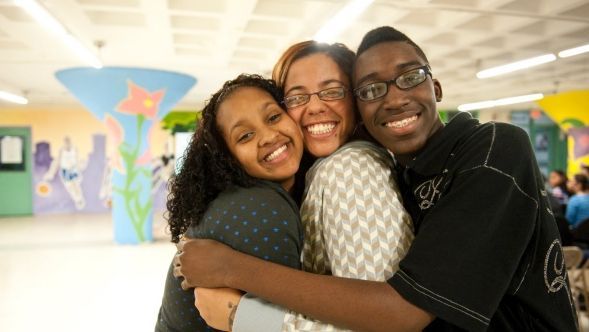
As a parent, after a long day at work, the kid’s homework is complete and they are in bed, you sit down to watch television. Grabbing your child’s phone, you do a check of text messages, apps and their internet browser. You are caught off guard when you see a sexually explicit image sent from the phone to another person.
Panic suddenly sets in. Do you wake your child up and yell at them? Do you sit on the information until you can think clearly? Upon further investigation on the phone, you discover this is a deeper problem than you first thought.
Help is available at
Child and Adolescent Behavioral Health (C&A). C&A offers a Healthy Sexuality Group for kids who struggle with sending inappropriate messages. But as a parent, who maybe grew up in the ‘80s or ‘90s, what is considered inappropriate today.
WHAT IS INAPPROPRIATE BEHAVIOR?
Sexually Inappropriate Behavioral Remediation (SIBR) Program Manager Dr. Seandra Walker discussed what is considered inappropriate behavior.
Dr. Walker said, “Inappropriate sexual behavior may include sending or receiving nude photos (including sexting and sextortion), inappropriate or excessive pornography use, inappropriate masturbatory behavior or highly sexualized behavior that may make a youth at risk for human trafficking.

“Teenagers are extremely tech-savvy and use electronics to communicate with their peers every day. However, many teenagers do not fully understand some of the legal ramifications of their online behaviors. For example, many teenagers do not know that sending and receiving nude photos from a same-aged peer is a crime in the state of Ohio. Lack of information regarding state and federal laws, as well as sexual beliefs or attitudes based on misinformation are common reasons why a youth is referred to the Healthy Sexuality program.”

HOW IS SOMEONE REFERRED TO THIS GROUP?
Dr. Walker provided different scenarios for an adolescent to be placed in this group. The first way, if a client is already a C&A client, their primary provider can submit a referral form. If the adolescent is not already a C&A client, an intake assessment would need to be completed and Healthy Sexuality services would be requested. A parent could call in and indicate their child needs this service.
WHAT DOES HEALTH SEXUALITY GROUP SESSIONS LOOK LIKE?
The initial session for this group is a parent/legal guardian-only session. The clinician leading the group will have:
- Group introduction and review curriculum content/modules
- Provide handouts and information related to improving safety measures at home regarding sexual boundaries, privacy and internet use
- Group rules, expectations and attendance policy
- Review and sign behavioral health service plan, detailing program goals/objectives

- Additional services available/offered
- Contact information given for parents to use if they would like to engage in additional meetings with the therapist regarding the program or their child
- Question and answer
Healthy Sexuality is an eight-week group program. Sessions are 90 minutes long and are held once a week at the Belden office.

WHAT TAKES PLACE IN THESE SESSIONS?
Adolescents in these sessions are ages 13 to 18. Group sessions are by gender – a boy’s group and a girl’s group, which helps youth feel more comfortable in exploring topics such as puberty and dating.
Dr. Walker said, “Initially, many of the youth are feeling nervous about attending group because they do not know what to expect. Additionally, the topics being taught may be uncomfortable for some youth to discuss.
“This is not therapy, which means the youth are not sharing or processing their own personal stories/experiences. The group is more psychoeducation in nature (similar to the classroom), so youth are not asked to disclose why they are attending group. The youth are expected to participate in discussions regarding the topics being addressed but are not asked to share personal information about themselves.”
Each session is lead by a group facilitator based on a set curriculum. The topics discussed include developing and maintaining healthy relationships, dating, communication skills, boundaries, sexual education, laws of consent and electronic sexual behavior, human trafficking, effects of pornography and victim impact.
Dr. Walker explained in between the one-week sessions, if the youth has another provider (therapist, peer advocate or community psychiatric support treatment), the provider can check in with the youth regarding their thoughts and feelings about group, and discuss how the information being discussed relates specifically to the youth.
THE END GOAL –
“The end goal is for the youth to have a better understanding of how to develop and maintain healthy relationships moving forward,” said Dr. Walker. “The youth are administered a pre-test and post-test regarding some of the information that is being addressed in group. Another goal is that the youth show improvement on their post-test compared to the pre-test.”
At the end of the group, if the adolescent is stills struggling with inappropriate sexual behavior, it is usually recommended that they work with one of the SIBR therapists in individual/family therapy to address specific concerns.
Dr. Walker said a new group usually starts every two months. As a parent, if you think your child is having issues with appropriate healthy sexual behavior, please contact C&A at 330-433-6075.
C&A’s Sexually Inappropriate Behavior Remediation Program Manager Dr. Seandra Walker provided the content for this blog post. Dr. Walker is one of C&A’s expert clinicians with more than seven years of clinical experience
RECENT POSTS












